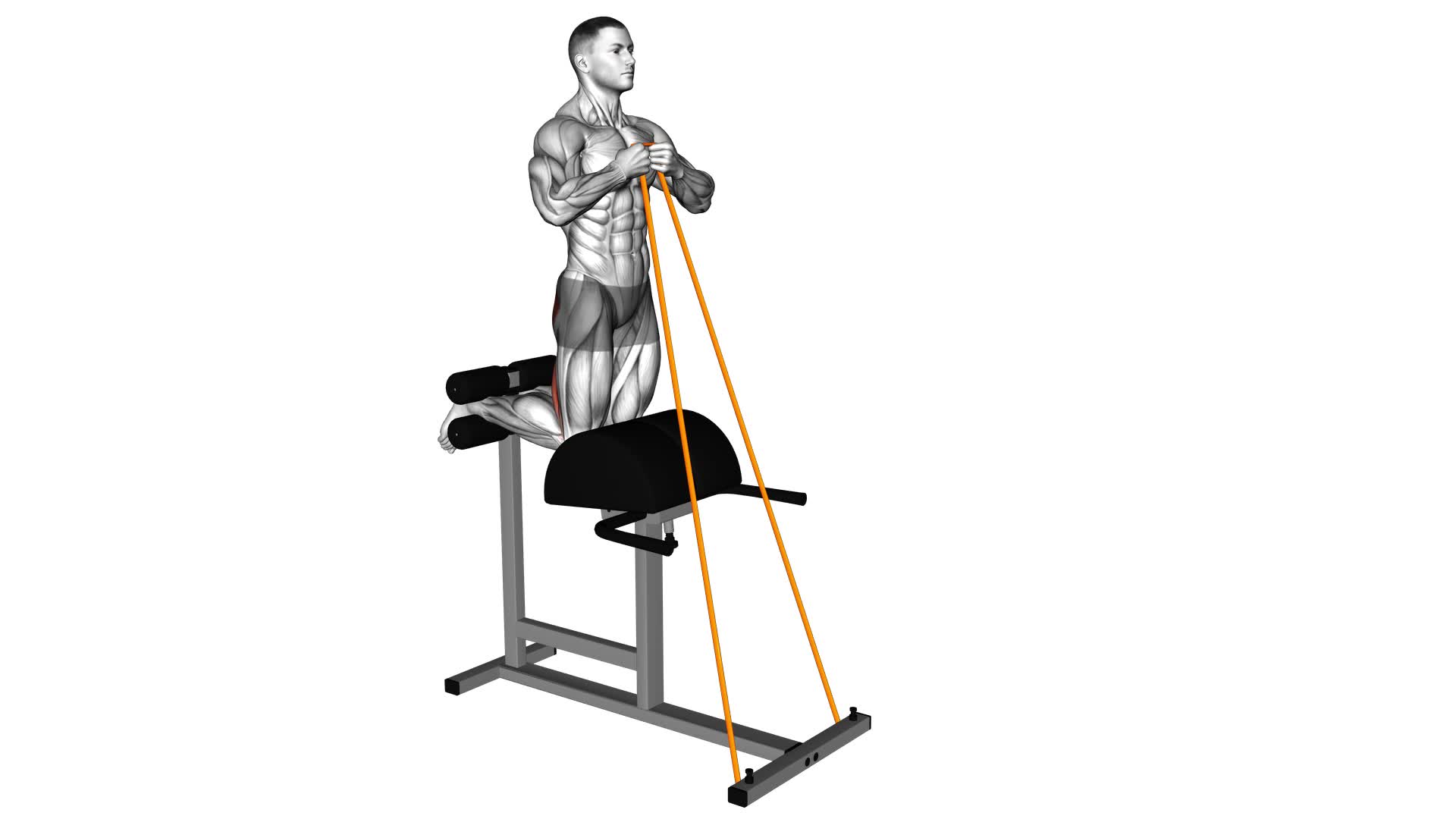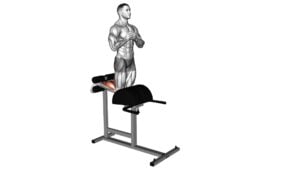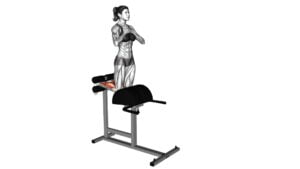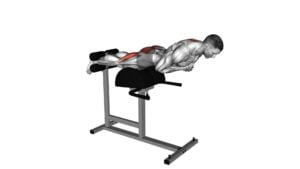Banded Glute Ham Raise (VERSION 2) – Video Exercise Guide & Tips

Are you looking to target your glutes and hamstrings? Look no further than the Banded Glute Ham Raise (Version 2).
Watch This Exercise Video
This exercise is effective in building strength and improving stability in your lower body. With just a resistance band, you can perform this exercise anywhere.
Watch the video guide and follow the tips to ensure proper form and get the most out of your workout.
Get ready to feel the burn and see results!
Key Takeaways
- The banded glute ham raise targets and strengthens glutes, hamstrings, and lower back muscles.
- Adding resistance with bands increases intensity and allows for customization of the exercise.
- Proper form and technique, including engaging core muscles and avoiding potential injuries, are crucial for maximizing results.
- Variations and modifications, such as the single leg banded glute ham raise and incorporating a Swiss ball, can target different muscle groups and prevent plateaus.
Benefits of the Banded Glute Ham Raise (VERSION 2)
Discover the numerous advantages of incorporating the banded glute ham raise (VERSION 2) into your workout routine. This exercise offers several benefits that can enhance your lower body strength and overall fitness.
One of the main advantages of the banded glute ham raise is its ability to target and strengthen the glutes, hamstrings, and lower back muscles. By adding resistance bands to the exercise, you can modify the intensity and challenge yourself even further. These bands provide constant tension throughout the movement, forcing your muscles to work harder and increasing the effectiveness of the exercise.
Additionally, the banded glute ham raise helps improve your hamstring flexibility. As you lower your body down, you engage your hamstrings in an eccentric contraction, which helps lengthen and strengthen these muscles. This can be particularly beneficial for athletes who rely on explosive lower body movements, such as sprinting and jumping.
To maximize the benefits of the banded glute ham raise, it's important to focus on proper technique. Make sure to keep your core engaged, maintain a neutral spine, and avoid excessive arching or rounding of the back. Start with a lighter band and gradually increase the resistance as you get stronger.
Equipment Needed for the Banded Glute Ham Raise (Version 2)
To perform the Banded Glute Ham Raise (Version 2), you'll need a resistance band. There are various options available, such as loop bands or flat bands, depending on your preference.
Using bands adds resistance to the exercise, making it more challenging and effective for targeting your glutes and hamstrings.
Resistance Band Options
For the Banded Glute Ham Raise (Version 2), you'll need resistance bands as part of your equipment. Resistance bands are versatile tools that can be used for a variety of exercises, making them a great alternative to the glute ham raise.
When it comes to choosing the right resistance band for this exercise, there are a few options to consider. Firstly, you can use a single loop band by placing it around your ankles and securing it to an anchor point. Another option is using a long resistance band, which can be wrapped around your feet or ankles and secured to a stable object.
Whichever type of resistance band you choose, incorporating them into your glute ham raise routine can provide additional resistance and help you target your glutes and hamstrings more effectively.
Benefits of Using Bands
When incorporating resistance bands into your glute ham raise routine, you can experience additional benefits and enhance the targeting of your glutes and hamstrings.
The use of bands adds resistance throughout the entire range of motion, increasing the effectiveness of the exercise. The bands provide constant tension, forcing your muscles to work harder and engage more fibers, resulting in greater muscle activation and development.
This added resistance also helps to improve stability and control during the movement, as you have to work against the band's pull. Additionally, using bands can help to correct muscle imbalances and strengthen the posterior chain, which is crucial for overall lower body strength and performance.
Proper Form and Technique for the Banded Glute Ham Raise (Version 2)
Maintain proper alignment and engage your glutes and hamstrings during the Banded Glute Ham Raise (Version 2). This exercise is highly effective for targeting and strengthening your posterior chain.
To ensure you get the most out of your workout, here are some tips for better results:
- Common Mistakes:
- Arching your back: Keep your spine neutral throughout the movement to avoid unnecessary strain on your lower back.
- Using momentum: Focus on controlled movements, resisting the band's tension both on the way up and down.
- Neglecting the eccentric phase: Don't rush through the lowering phase; maintain control as you extend your body.
- Tips for Better Results:
- Engage your glutes: Squeeze your glute muscles at the top of the movement to maximize activation and strengthen your posterior chain.
- Maintain core stability: Brace your core throughout the exercise to stabilize your body and protect your lower back.
- Gradually increase resistance: As you get stronger, use bands with higher tension to continue challenging your muscles.
Variations and Modifications for the Banded Glute Ham Raise (Version 2)
To add variety and challenge to your glute and hamstring workout, try incorporating different variations and modifications of the Banded Glute Ham Raise (Version 2). These variations can help target specific muscle groups and increase the effectiveness of your exercise routine.
One variation you can try is the Single Leg Banded Glute Ham Raise. This variation focuses on unilateral glute activation and hamstring strength. To perform this exercise, place one foot in the band and bend at the knee while keeping the other leg straight. Lower your body down until your torso is parallel to the ground and then raise back up using your glutes and hamstrings. Repeat on the other leg.
Another modification to consider is the Banded Glute Ham Raise with a Swiss ball. This variation adds an element of instability, forcing your glutes and hamstrings to work harder to stabilize your body. Place a Swiss ball under your feet and perform the exercise as you would with the regular banded glute ham raise.
By incorporating these variations and modifications into your glute and hamstring workout, you can target different muscle groups and challenge yourself in new ways. This will help prevent plateaus and keep your workouts interesting.
Now let's move on to the next section, where we'll discuss common mistakes to avoid during the banded glute ham raise (version 2).
Common Mistakes to Avoid During the Banded Glute Ham Raise (Version 2)
Avoiding common mistakes is crucial when performing the Banded Glute Ham Raise (Version 2) to ensure proper form and maximize the effectiveness of the exercise. To help you avoid these common errors, here are some key mistakes to be aware of:
- Using too much momentum: It's important to maintain control throughout the movement and avoid swinging your body. This ensures that your glutes and hamstrings are properly engaged and targeted.
- Lifting your hips too high: Raising your hips excessively can lead to improper form and reduce the effectiveness of the exercise. Keep your body in a straight line from your head to your heels, and avoid lifting your hips higher than necessary.
- Neglecting core activation: Your core plays a crucial role in stabilizing your body during the Banded Glute Ham Raise. Failing to engage your core muscles can lead to poor posture and potential strain on your lower back.
By being mindful of these mistakes and focusing on proper form, you can optimize your workout and avoid potential injuries.
Now, let's move on to some tips that will help you maximize your results with the banded glute ham raise (version 2).
Tips to Maximize Your Results With the Banded Glute Ham Raise (Version 2)
By focusing on proper form and incorporating these tips, you can maximize your results with the Banded Glute Ham Raise (Version 2).
One important tip is to engage your glutes fully during the exercise. To do this, squeeze your glutes as you raise your body up, making sure to keep your hips aligned with your body. This will help to maximize glute activation and ensure that you're targeting the right muscles.
Another tip is to control the movement throughout the exercise. Avoid using momentum to swing yourself up, as this can take the focus away from your glutes and hamstrings. Instead, focus on using the strength of your hamstrings to lift your body up and slowly lower yourself back down with control.
Additionally, it's important to gradually increase the resistance of the band as you get stronger. This will help to increase hamstring strength and further challenge your muscles. Start with a lighter band and gradually work your way up to a heavier one as you progress.
Lastly, make sure to breathe properly during the exercise. Take deep breaths in and exhale as you raise your body up. This will help to stabilize your core and provide better support for your spine.
Frequently Asked Questions
Can the Banded Glute Ham Raise (Version 2) Be Done Without Any Resistance Bands?
Yes, you can still do the glute ham raise without using any resistance bands. However, using resistance bands can provide additional benefits.
They help to increase the intensity of the exercise by adding resistance throughout the movement, which can help to strengthen and tone your glutes, hamstrings, and lower back.
Additionally, there are variations of the glute ham raise that can be modified for different fitness levels, allowing everyone to benefit from this exercise.
How Often Should the Banded Glute Ham Raise (Version 2) Be Performed for Optimal Results?
To achieve optimal results with the banded glute ham raise (version 2), it's important to perform this exercise regularly.
The benefits of this exercise include strength and muscle development in the glutes and hamstrings.
For best results, aim to incorporate this exercise into your workout routine at least 2-3 times per week.
For advanced athletes, there are variations and progressions available to further challenge yourself and continue making progress.
Can Beginners Perform the Banded Glute Ham Raise (Version 2)?
Yes, modifications can be made for beginners performing the banded glute ham raise (version 2). It may be challenging at first, but you can adjust the band tension or use a lighter band to make it more manageable.
If you find the exercise too difficult, there are alternative exercises you can try to strengthen your glutes and hamstrings. Some options include glute bridges, hamstring curls, or lunges.
Remember to start at your own pace and gradually increase the intensity as you progress.
Are There Any Specific Warm-Up Exercises That Should Be Done Before Attempting the Banded Glute Ham Raise (Version 2)?
Before attempting the banded glute ham raise (version 2), it's important to warm up your muscles properly. There are specific warm-up exercises you can do to prepare for this exercise.
Additionally, if you don't have resistance bands, there are alternative ways to perform the banded glute ham raise (version 2).
Incorporating these warm-up exercises and finding suitable alternatives will help you safely and effectively perform this exercise.
Can the Banded Glute Ham Raise (Version 2) Be Done at Home Without Any Specialized Equipment?
Yes, there are alternative exercises for glute activation that can be done at home without any specialized equipment. Some examples include glute bridges, hip thrusts, and single-leg deadlifts. These exercises target the glutes and can help strengthen and activate them.
However, it's important to note that glute ham raises have specific benefits for hamstring development. They target the hamstrings and glutes in a unique way, helping to build strength and improve overall lower body performance.
Conclusion
In conclusion, the banded glute ham raise (version 2) is a highly effective exercise for targeting and strengthening the glutes and hamstrings.
By using resistance bands, you can increase the intensity and challenge of the exercise.
Proper form and technique are essential for maximizing results and avoiding common mistakes.
With variations and modifications available, this exercise can be tailored to individual fitness levels.
Incorporating the banded glute ham raise into your workout routine can help you achieve stronger and more defined glutes and hamstrings.

Author
Years ago, the spark of my life’s passion ignited in my mind the moment I stepped into the local gym for the first time. The inaugural bead of perspiration, the initial endeavor, the very first surge of endorphins, and a sense of pride that washed over me post-workout marked the beginning of my deep-seated interest in strength sports, fitness, and sports nutrition. This very curiosity blossomed rapidly into a profound fascination, propelling me to earn a Master’s degree in Physical Education from the Academy of Physical Education in Krakow, followed by a Sports Manager diploma from the Jagiellonian University. My journey of growth led me to gain more specialized qualifications, such as being a certified personal trainer with a focus on sports dietetics, a lifeguard, and an instructor for wellness and corrective gymnastics. Theoretical knowledge paired seamlessly with practical experience, reinforcing my belief that the transformation of individuals under my guidance was also a reflection of my personal growth. This belief holds true even today. Each day, I strive to push the boundaries and explore new realms. These realms gently elevate me to greater heights. The unique combination of passion for my field and the continuous quest for growth fuels my drive to break new ground.







